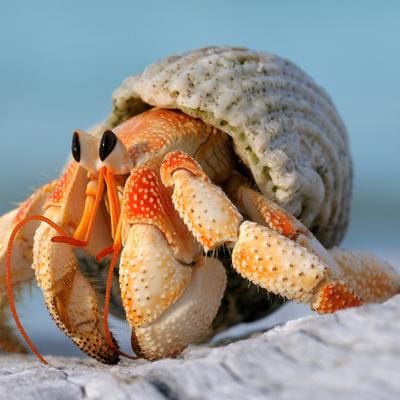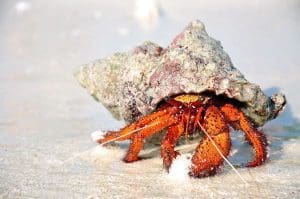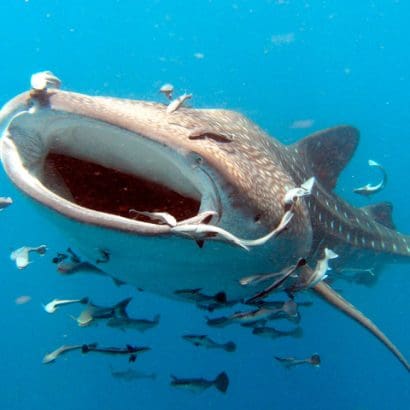
The marine world is full of fascinating creatures, and hermit crabs are no exception. These small crustaceans have a very peculiar way of protecting themselves and obtaining food, which makes them a unique species. In this article, we will explore the secrets of hermit crabs, from their anatomy to their behaviors and most interesting curiosities. We’ll discover how they use shells to protect themselves, how they obtain their food, and what makes them so special in the world of marine life. Get ready to dive into the fascinating world of hermit crabs and learn about one of the most unique and surprising species that inhabits the ocean.
Contents
What are hermit crabs?.🐋
Hermit crabs are crustaceans belonging to the Paguridae family. Despite their name, these animals are not true crabs, but are more closely related to shrimps and lobsters. Hermit crabs are characterized by having a soft, curved body that is protected by an empty shell of another animal, usually a marine snail. As the hermit crab grows, it must find a larger shell to protect its body. Often, hermit crabs compete for available shells, and some even take shells from other hermit crabs.
Hermit crabs are found worldwide, from cold waters of the Arctic to tropical waters. They live in a variety of marine habitats, including coral reefs, rocky bottoms, and sandy beaches. Some species can also live in freshwater.
Hermit crabs are ecologically important, as they are important for maintaining balance in the marine ecosystem. In addition, hermit crabs are a popular species as pets, although caution should be taken when keeping them in captivity, as they require a proper aquatic environment and balanced diet to stay healthy.
How do hermit crabs protect themselves?.🐋
Hermit crabs have a unique way of protecting themselves thanks to their shell. As the hermit crab grows, it needs to find a larger shell to live in. When it finds a suitable shell, the hermit crab grips it with its claws and drags it towards its body. The hermit crab then crawls into the shell, leaving only its legs, antennae, and eyes outside. In this way, the empty shell protects the hermit crab’s soft body from predators.
 In addition to their shell, hermit crabs have other strategies for protection. When they feel threatened, they can hide inside their shell and close the opening with their claws. They can also release their limb if caught by a predator and regenerate it later. This regenerative ability allows them to escape predators and recover from injuries.
In addition to their shell, hermit crabs have other strategies for protection. When they feel threatened, they can hide inside their shell and close the opening with their claws. They can also release their limb if caught by a predator and regenerate it later. This regenerative ability allows them to escape predators and recover from injuries.
Another defensive strategy used by hermit crabs is their ability to blend in with their environment. Some species have legs that resemble twigs or algae, allowing them to camouflage themselves in the seabed and avoid predators.
How do hermit crabs obtain their food?.🐋
Hermit crabs obtain their food from various sources in their natural habitat, including decaying organic matter, marine plants, small invertebrates, detritus, and carrion. These crustaceans are opportunistic animals, meaning that they feed on any available food.
 One of the most important foods for hermit crabs is mollusk shells. Hermit crabs use their claws to break the shells and extract their nutritious contents. They can also gnaw and wear down the edges of the shells to make them more manageable and extract their contents more easily.
One of the most important foods for hermit crabs is mollusk shells. Hermit crabs use their claws to break the shells and extract their nutritious contents. They can also gnaw and wear down the edges of the shells to make them more manageable and extract their contents more easily.
In addition to mollusk shells, hermit crabs also feed on small marine animals such as shrimp, worms, and other crustaceans. To obtain these foods, hermit crabs use their claws to capture and tear the flesh of their prey. They can also rake the sea floor for food or search for detritus and carrion that float on the surface.
Another food source for hermit crabs is algae and other marine plants. These crustaceans can tear off and eat small parts of marine plants, using their claws to grip and cut the pieces of food.
Curiosities about hermit crabs.🐋
Hermit crabs are fascinating animals that exhibit a number of interesting curiosities and behaviors. Below are some of the most notable curiosities about hermit crabs:
- They are known as “hermits” due to their habit of carrying shells on their body for protection. These crustaceans have a soft and unprotected abdomen, so they use empty mollusk shells as a refuge.
- Hermit crabs do not have their own shell and therefore need to find a suitable shell for protection and growth. As the hermit crab grows, it seeks larger shells and abandons smaller ones. This behavior makes empty shells a very important resource for other animals that use them as a refuge
- Unlike true crabs, hermit crabs have a spirally coiled abdomen. This unique design allows the hermit crab to easily enter and exit the shell.
- The hermit crabs have a relatively long lifespan compared to other crustaceans and can live between 15 and 30 years in their natural habitat.
- The hermit crabs have an impressive ability to regenerate their legs and claws. If they lose a limb due to a predator attack or injury, they can fully regenerate it in a few weeks.
Warnings about Hermit Crabs.🐋
Hermit crabs are fascinating animals and popular as pets due to their unique appearance and interesting behavior. However, it is important to keep in mind that caring for these crustaceans requires certain precautions and responsibilities. The following are some important warnings for those who wish to keep hermit crabs as pets:
Habitat size:
Hermit crabs need a habitat large enough to move and grow properly. A tank that is too small can be harmful to their health and well-being. A minimum size of 10 gallons per hermit crab is recommended.
Humidity and temperature:
Hermit crabs are tropical animals and require a warm and humid environment to survive. The air humidity in the habitat should be between 70% and 80%, and the temperature should range between 24°C and 27°C.
Proper feeding:
Hermit crabs are omnivores and need a balanced diet that includes proteins, vitamins, and minerals. They can be fed a variety of foods, such as shrimp pellets, vegetables, fruits, and other fresh foods.
Shell changing:
It is important to provide hermit crabs with empty shells of different sizes so they can change shells as they grow. The shells should be clean and disinfected before being offered to the hermit crabs.
Species compatibility:
Hermit crabs can be aggressive towards each other and other species of crustaceans. Therefore, it is important to ensure that the species in the same habitat are compatible.
Habitat care and cleaning:
It is important to keep the hermit crab’s habitat clean and well-maintained. The aquarium water should be changed regularly, and waste and leftover food should be removed to prevent infections and diseases.
If you want to learn some recipes with crabs, I invite you to click here.


